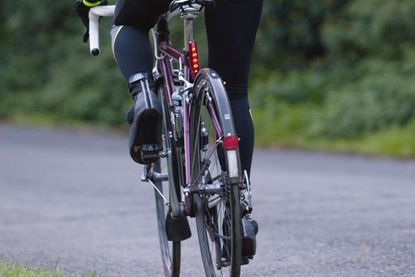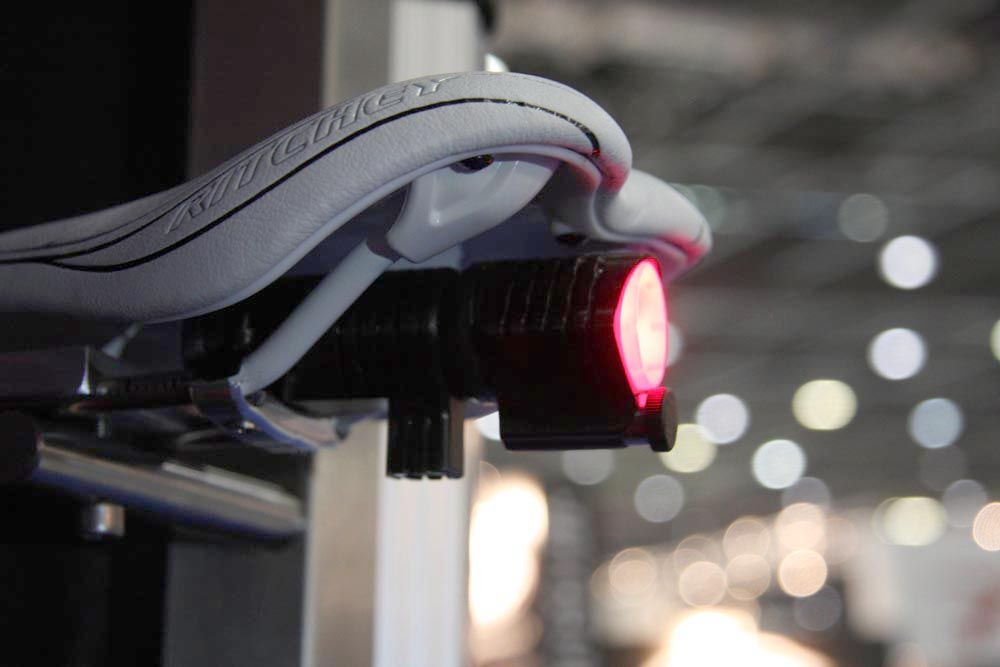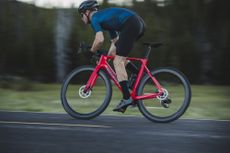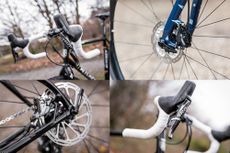Buyer's guide to rear lights
Here's our guide to make sure that you pick a good rear light that will keep you visible this winter
- (opens in new tab)
- (opens in new tab)
- (opens in new tab)
- Sign up to our newsletter Newsletter

If you're looking to ride through the winter, then you're really going to need some good lights to attach to your bike. While you'll be buying a front light to light up the road in front of you to let you see where you're going, from a safety point of view, the rear one is perhaps more important, making sure that drivers approaching from behind can always see you and overtake safely.
>>> Buyer's guide to cycling lights
So what should you be looking for in a good rear light for your bike in order to make sure that your winter and nightime riding can be as safe as possible?
Legal Requirements
Why you can trust Cycling Weekly Our expert reviewers spend hours testing and comparing products and services so you can choose the best for you. Find out more about how we test.
By law, according to the Road Vehicles Lighting Regulations, if you're riding between sunset and sunrise, then you must display a red rear light (as well as white front light, red rear reflector, and two pedals reflectors on each pedal).
The rear light must be positioned centrally, 35cm to 150cm from the floor, and visible from the rear. It must also conform with the relevant safety standards, and if flashing emit a minimum of four lumens.
>>> Garmin Edge computers: a complete buyer's guide
Of course in reality, these requirements are rarely enforced, and we can't really imagine you being pulled over and reprimanded by the police on account of having your rear light 170cm from the floor. However, it is always wise to conform to the regulations, not only on safety grounds, but just in case you find yourself in court after being involved in a collision.
Brightness
One of the most important things to look at in a rear light (or any light for that matter) is how bright it is. While a serious heavy-front light can be expected to pump out thousands of lumens, you really don't need this sort of brightness at the rear. In fact, even the very brightest rear lights are unlikely to pump out much more than 75 lumens, which is more than enough to make you seen.
>>> Buyer's guide to road bike groupsets
Much more important is where all this light is directed. Obviously you want most of it pointing backwards so that cars approaching from behind are able to see you, but sideways visibility should always be a major consideration too. Especially if you're riding in built-up areas then it's really important to make sure that drivers emerging from side junctions can see you as well as those approaching from in front or behind. Therefore look for rear lights which have clear sides in order to avoid taken out from vehicles emerging from side roads.
Modes
A key consideration in deciding which rear light to buy is the number of modes that it has, and in general the more modes the better. The most basic of rear lights will often only have a single flashing mode, but pay a little more and you'll often find lights with multiple constant and flashing modes. Rear lights with more than one LED or bulb will often also have modes where one LED is on while the other flashes, as well as different levels of brightness.
>>> 15 top tips for commuting to work by bike
This is useful on a number of levels. Firstly it allows you to be flexible when it comes to light conditions. Slightly counterintuitively, the darker it is the less bright your rear light needs to be, so if you're riding on dark, unlit lanes then you should be easily be spotted even if your rear light is flashing away on its lowest setting. However, if you're riding towards a low sun, and have your rear light on in order to help drivers see you in the brightness of the sun, then you'll want your light to be as bright as possible.
>>> Buyer's guide to road bike tyres
Multiple modes will also help you to preserve battery life, so if you've forgotten to charge your rear light and are worried that it might be running low, then you can put it on a lower setting in order to get you home safely. That said, plenty of the better rear lights on the market now come with a low battery mode, which automatically switches the light into a less energy-sapping mode in order to get you home safely.
Watch our pick of the five sexiest superbikes of 2015
Battery life and charging
Even if your rear light does have a low battery mode, battery life still has to be a key consideration. It's really better to be safe than sorry with these sort of things, so the longer the battery life the better, and you should really be looking for a rear light that would be able to cope with at least a week of commutes in order to keep your mind at rest.
>>> Brompton: the perfect commuting machine
However, probably more important is what batteries the rear light uses, and whether they are rechargeable. If you're looking to get a good, convenient rear light, then it's really worth getting one that is rechargeable. There are plenty around that are powered by coin cell, AA or AAA batteries, but these leave you guessing as to when they might run out of juice.
>>> Buyer's guide to winter cycling gloves
The beauty with USB rechargeable ones is that you can just keep the charging cable at home or at work, and plug it in whenever you think your light might need a boost. What's more, plenty of rear lights are now charged using micro-USB cables, which you're likely to already have lying around at home somewhere, meaning that is you lose the cable that comes with the light then it's not the end of the world.
Mounts
The final big consideration is how your rear light is going to attach to your bike. Basically what you're after is a mount that will keep your rear light firmly in place and pointing in the right direction, so even if you hit some pretty big potholes on some gloomy lanes, your not going to have your nice new light bouncing off into the bushes.
>>> The 25 best pieces of cycling advice
If you're got a standard round seatpost, then mounting your light shouldn't be too much of an issue (although if you've got a 31.8mm seatpost then some mounts can be a little tight). However if you're attaching your rear light to a bike with an aero seatpost, then things can be a bit more difficult.

If this is you then look for lights which attach using a long silicon band, or ones which are designed in such a way that they can be mounted either elsewhere on the bike, such as underneath the saddle or on your seatstays.
Our pick of the best rear lights

Bontrager Flare R rear light
£44.99

Lezyne KTV Drive front and rear lightset
The new format Lezyne KTV Drive light set has plenty of output for commutes or daytime running, in a compact
£37.99

Exposure Blaze rear light
Exposure Blaze acts as a bright, compact and easy to use rear light which our tester liked.
£99.95

Hope District Plus Rear Light
Hope do provide extra special pieces of kit that work thoroughly well, though is a rear light with an external
£95

B'Twin VIOO Front/Rear Bike Light
£8.5
How much should I spend?
The good news is that while you probably have to go well into three figures in order to buy a top-quality front light that's suitable for the darkest conditions, you don't have to spend nearly this much on your rear light. In fact thirty quid or so should be more than enough to buy a very good front light that will be bright and include all the key features, while if you're just riding on lit roads then you can get away with much less than this.
How we score
10 – Superb, best in its class and we couldn’t fault it
9 – Excellent, a slight change and it would be perfect
8 – Brilliant, we’d happily buy it
7 – Solid, but there’s better out there
6 – Pretty good, but not quite hitting the mark
5 – Okay, nothing wrong with it, but nothing special
4 – A few niggles let this down
3 – Disappointing
2 – Poor, approach with caution
1 – Terrible, do not buy this product

Thank you for reading 10 articles this month* Join now for unlimited access
Enjoy your first month for just £1 / $1 / €1
*Read 5 free articles per month without a subscription

Join now for unlimited access
Try first month for just £1 / $1 / €1
Henry Robertshaw began his time at Cycling Weekly working with the tech team, writing reviews, buying guides and appearing in videos advising on how to dress for the seasons. He later moved over to the news team, where his work focused on the professional peloton as well as legislation and provision for cycling. He's since moved his career in a new direction, with a role at the Department for Environment, Food and Rural Affairs.
-
-
 High-end bikes still in demand, says Giant as it announces 12.5% revenue increase
High-end bikes still in demand, says Giant as it announces 12.5% revenue increaseBut like much of the industry the Taiwanese manufacturer is also experiencing a surplus of low to mid priced stock
By James Shrubsall • Published
-
 Milan-San Remo 2023: Route and start list
Milan-San Remo 2023: Route and start listAll you need to know about the first Monument of the 2023 season
By Ryan Dabbs • Published
-
 The best cycling multi-tools and Allen keys 2023
The best cycling multi-tools and Allen keys 2023A cycling multi-tool and a set of Allen keys are a cyclist's best friends for on-the-road adjustments and fettling at home
By Stefan Abram • Published
-
 Best handlebar bags 2023
Best handlebar bags 2023The best handlebar bags will let you carry a good proportion of your bikepacking gear or just your extras for a day ride
By Stefan Abram • Last updated
-
 Best bike locks 2023: heavy duty and portable locks for keeping your bike safe
Best bike locks 2023: heavy duty and portable locks for keeping your bike safeYou'll want one of the best bike locks if you plan to leave your bike unattended at any time - here’s what to look for and an overview of some of the best locks on the market
By Simon Smythe • Last updated
-
 Best road bike wheels reviewed and rated: disc and rim wheelsets to supercharge your ride
Best road bike wheels reviewed and rated: disc and rim wheelsets to supercharge your rideOur complete guide to what to look for in the best road bike wheels
By Paul Norman • Last updated
-
 Best cycling vests 2023: extra warmth when you need it
Best cycling vests 2023: extra warmth when you need itCycling vests are one of the most flexible pieces of clothing in your cycling wardrobe. We explain what should you be looking for and round up our favourites.
By Henry Robertshaw • Last updated
-
 Best aero bikes 2023: fastest speed weapons ridden and rated
Best aero bikes 2023: fastest speed weapons ridden and ratedWe've ridden and rated the best aero bikes and these are our favourites
By Paul Norman • Last updated
-
 The best summer cycling clothing for 2017
The best summer cycling clothing for 2017Summer is here so it's time to dress properly for the warmer weather. Our buyer's guide can help you make all the right choices when it comes to summer cycling kit
By Henry Robertshaw • Published
-
 Disc brakes: everything you need to know
Disc brakes: everything you need to knowYour complete guide to disc brakes on road bikes
By James Bracey • Published









